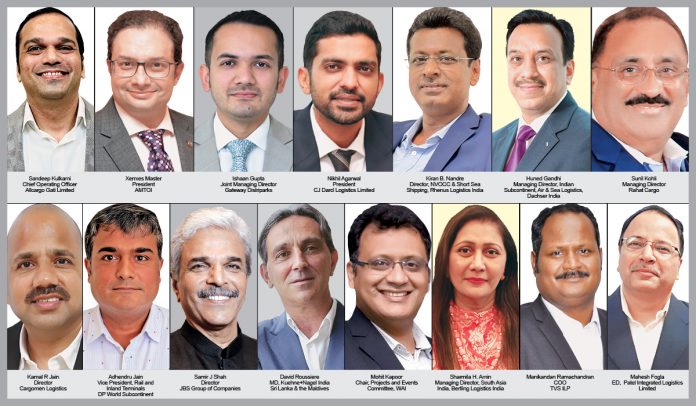India’s multimodal supply chain network is evolving, and logistics players continue to redefine ways of operating to achieve seamless connectivity for businesses. Multimodal connectivity ensures improved utilisation of transportation, leading to reduction in costs, transit time and flexibility with increased reliability. The government’s emphasis on development of MMLPs and DFCs has allowed businesses throughout India to streamline their operations and rely on seamless last-mile connectivity.
Ritika Arora Bhola
Multimodal transportation is vital to ensure rapid and uninterrupted supply chain operations. Over the years, the government has implemented several cost-effective initiatives by investing into infra and improving connectivity through different modes of transportation. Some of the govt initiatives include Make in India, Digital India, Sagarmala, DFCs and MMLPs.
Bharatmala Pariyojana has moved into its next phase, with an additional allocation aimed at linking remaining hinterlands to mainstream logistics networks, thereby enhancing road transport’s reach and efficiency. Sagarmala, focusing on port connectivity, has seen the completion of 50 projects, thereby reducing TAT in ports by 20 per cent, reflecting in gross reduction of logistics costs annually. The DFCs, particularly the Eastern and Western corridors, are operational, with reports indicating a 50 per cent reduction in transit times for freight trains and an increase in freight volume capacity.
The State of infrastructure
- Rail: The completion of key DFC sections in 2024 stands as a milestone. However, integrating these with the existing network to leverage their capacity remains a challenge, alongside the need for digital upgrades for seamless operations.
- Road: With 40,000 km of highways constructed under Bharatmala project by 2024, the focus shifts towards enhancing quality of rural and feeder roads to improve last-mile connectivity.
- Air: The sector has witnessed a growth spurt, with volumes likely to grow by 10 per cent in 2024, driven by modernisation of airports and introduction of direct cargo flights. But high operational costs and capacity constraints at smaller airports restrict the sector’s potential.
Current challenges
While India has made significant strides, the logistics sector in this year continues to face multifaceted challenges:
Regulatory efficiency: Despite improvements, complex regulatory procedures, and a lack of cohesive policy enforcement across states create logistical inefficiencies.
Technological integration: Though adoption of AI, IoT, and Blockchain has increased, but is not yet widespread, particularly among SMEs, highlighting a digital divide.
Sustainability practices: As India commits to reducing its CO2 footprint, the sector struggles to balance growth with environmental sustainability, emphasising the need for greener logistics solutions.
Multimodal logistics in 2024
The trajectory of India’s multimodal logistics sector reflects a mixture of achievements and challenges. The government’s focus on infra development and policy reforms sets a solid growth foundation. Yet, this sector’s potential hinges on addressing existing operational inefficiencies, embracing digital transformation, and prioritising sustainability. As India looks towards the future, alignment of strategies across governmental, industrial, and technological spheres will be paramount in realising the vision of a seamless and efficient multimodal logistics network. Commitment to sustainability is key to navigating complexities of this sector, propelling India towards becoming a global logistics leader. India’s logistics sector is currently undergoing a transformation towards multimodal transportation. CARGOTALK speaks to industry experts about challenges, progress, and the future.
Efforts on to increase road link through Bharatmala
Sandeep Kulkarni, Chief Operating Officer, Allcargo Gati Limited
In recent years, the government has improved multimodal connectivity to increase efficiency. Initiatives such as Bharatmala Pariyojana, Sagarmala Programme, Make in India, and DFCs were vital in improving road, maritime, and rail infra. NHs account for 40 per cent of India’s road traffic despite comprising 2 per cent of the total road network. Efforts are ongoing to increase the road network initiatives through the NHDP and Bharatmala Pariyojana. LEEP intends to improve logistics efficiency by developing MMLPs. While progress has been made in modernising facilities, improvement is needed. Challenges such as fragmented infra and last-mile connectivity continue to prevent seamless freight flow. Overcoming these obstacles is critical for optimising supply chains.”
Sustainability significant for steering multimodal shortfalls
Xerrxes Master, President, AMTOI
Trajectory of multimodal logistics sector in 2024 reflects many achievements and ongoing challenges. The government’s focus on infra development and policy reforms sets a solid foundation for growth. This sector’s potential hinges on addressing operational inefficiencies and embracing digital transformation. As India looks ahead, alignment of strategies across governmental and technological spheres will be paramount to realise a seamless, and sustainable multimodal logistics network. Sustainability navigates this sector’s complexities. In 2024, the government aims to reduce logistical costs at 14 per cent of the GDP. Projects such as the DFCs made strides yet face challenges in integration and digital upgrades.”
Investment in infrastructure reforms is paramount
Ishaan Gupta, Joint Managing Director, Gateway Distriparks
Identifying the correct location is a key decision for us as there are multiple criteria that we must keep in mind—proximity to railway stations, connectivity to DFCs, main routes of Indian Railways, and highway connectivity. Gateway has been careful in selecting the correct locations—it is the core strategy in the logistics business. Multimodal transportation does face challenges, lack of integration between various modes of transportation resulting in delays. Addressing them will need investments in infra, reforms, and policy changes. The NLP aims to create a single-window e-logistics market, reduce logistics costs, and improve India’s competitiveness in global trade. PMGS is focused on creating a multimodal logistics network.”
Focus on infra development must to reduce logistics cost
Nikhil Agarwal, President, CJ Darcl Logistics Limited
The logistics sector may witness a transformation. Initiatives such as PMGS and NLP are driving this progress. By focusing on infrastructure development and reducing logistics costs, India’s logistics journey is manoeuvring its way through infrastructure gaps, limited digitalisation requiring increased investment in roads, rails, and supply chain visibility. Projects such as Bharatmala, Sagarmala, Udan, and DFCs are helpful in this regard. By embracing sustainable practices such as prioritising electric vehicles and developing green infrastructure, the government can create a network that is efficient and environmentally responsible.
Important to develop coastal, inland waterways
Kiran B. Nandre, Director, NVOCC & Short Sea Shipping, Rhenus Logistics India
Over the past some years, India has seen a push for multimodal connectivity. PMGS for integrated infrastructure projects, Bharatmala, Sagarmala, and DFCs have laid the groundwork. PPPs played a role in developing a network of roads, railways, warehouses, and port connectivity. This highlights the need for a shift towards coastal and inland waterways; India can take inspiration from European Union’s 200-year strategy for inland waterways. India is short of ships, barges, and smaller vessels for cargo movement on waterways. Smaller vessels linking smaller ports to hubs will cut dependence on foreign transhipment, save costs and promote cargo flow.”
PMGS, NLP to improve infra, update regulatory framework
Huned Gandhi, Managing Director, Indian Subcontinent, Air & Sea Logistics, Dachser India
Multimodal transportation emerges as cornerstone reshaping supply chains. With initiatives such as Bharatmala, Sagarmala, and development of inland waterways, India envisions a seamless convergence of rail, road, air, and water networks. By integrating these networks, logistics gain speed and cost-effectiveness, facilitating good flow across India. These efforts are bolstered by PMGS and NLP, which underscore the commitment to modernising infra and streamlining regulatory frameworks. PMGS aims to enhance infra connectivity across India, while NLP focuses on optimising logistics efficiency and reducing costs.”
SEZs to improve linkage, make businesses competitive
Sunil Kohli, Managing Director, Rahat Cargo
India launched PMGS to herald a new chapter in governance. PMGS brings 16 ministries for coordinated implementation of infrastructure connectivity. It will incorporate the schemes of various ministries and states such as Bharatmala, Sagarmala, inland waterways, dry/land ports, UDAN. The SEZs will be covered to improve linkage and make businesses competitive. Construction of highways have facilitated a seamless cargo flow from satellite towns to nearby airports.”
India needs more multimodal logistics networks
Kamal R Jain, Director, Cargomen Logistics
India is witnessing a surge in demand for logistics services across diverse sectors such as manufacturing, agriculture, retail, and e-commerce. This growth presents opportunities for logistics providers to cater to the needs of industries and consumers. Initiatives such as Make in India, Digital India, and Sagarmala to boost manufacturing, digital infrastructure, and maritime logistics stimulate growth and develop multimodal logistics networks. Ongoing projects such as DFCs, port modernisation, and development of inland waterways are poised to transform India’s logistics landscape. e-commerce in India has fuelled demand for efficient last-mile delivery.”
DFCs allowed businesses to rely on last-lime connectivity
Adhendru Jain, Vice President, Rail and Inland Terminals, DP World Subcontinent
India’s multimodal supply chain network is evolving, and logistics players continue to reinvent their ways of working to achieve seamless linkage for businesses. Multimodal connectivity will enable businesses to leverage the strengths of multiple modes of transportation. Multimodal linkage ensures improved utilisation of transportation infra leading to reduction in transit time. The government’s stress on development of MMLPs and DFCs has allowed businesses throughout India to streamline operations and rely on last-mile connectivity for their freight transportation needs. In the past two decades, DP World has built a multimodal supply chain network.”
Legal issues in multimodal logistics are a challenge
Samir J Shah, Director, JBS Group of Companies
The understanding of multimodal transportation is slowly dawning on stakeholders in India, but the legal issues, acceptability and interchangeability continue to remain a challenge. It is for the government to bring about a change along with the private sector. Road transport, rail linkage, airports, seaports and facilitating measures of state governments in setting up logistics infra is commendable. Our needs are different, funds limited, capacity of pay for services is local—efforts should be towards adequate infrastructure. Efforts to create infra have yet to be made. An umbrella ministry for logistics is a must. Stakeholders of different modes of transport must give common solutions.”
Addition of MMLPs to boost efficiency, reduce costs
David Roussiere, MD, Kuehne+Nagel India, Sri Lanka & the Maldives
Unlike Europe, India relies on road and rail transport, with waterways playing a secondary role. To enhance multimodal transportation in India, the government has recognised the role they play in boosting efficiency and reducing costs. One initiative is the creation of MMLPs at strategic locations in India. Under Bharatmala’s second phase, 11 new MMLPs are being added, bringing the total to 53 nationwide. By December 2023, 26,418 km have been awarded for construction with completion of 15,549 km.”
Eastern & Western DFCs enhance rail freight efficiency
Mohit Kapoor, Chair, Projects and Events Committee, WAI
The government has been working on initiatives to improve multimodal transportation and connectivity in India. Some of these include Bharatmala project that aims to develop a NH network linking economic corridors and remote areas. Sagarmala focuses on port-led development by modernising ports and integrating them with inland logistics infra. The Eastern and Western DFCs were developed to enhance the efficiency of rail freight transportation. The UDAN scheme has been promoting air link by making air travel affordable. Major airports are serving as cargo hubs for the growing cargo industry.”
Multimodal logistics to enhance India’s competitiveness
Sharmila H. Amin, Managing Director, South Asia India, Bertling Logistics India
Multimodal logistics, integrating transportation modes present opportunities for economic growth and development. However, it comes with its fair share of challenges. Multimodal transportation offers opportunities for efficiency and cost reduction by optimising routes. It enhances linkage between different regions, facilitating faster movement of goods and reducing transit times. Logistics can enhance India’s competitiveness in global markets by slashing logistics costs and improving reliability. India can integrate into global supply chains, attracting investment and fostering trade partnerships.”
By promoting rail freight, MMLPs can slash emissions
Manikandan Ramachandran, COO, TVS ILP
As India strides ahead with initiatives such as PMGS to fortify its multimodal logistics framework, TVS ILP stands poised to harness growth and focus on aligning a portion of future expansions alongside MMLPs. The MMLPs emerge as pivotal enablers, offering streamlined logistics and environmental benefits. By promoting rail-based freight movement and optimising transit efficiency through integrated transport models, the MMLPs hold the key to reducing emissions. Also, the rise of MMLPs has catalysed the emergence of warehouses at strategic points and enhancing connectivity for companies.”
Modernising, expanding modes of transport essential
Mahesh Fogla, ED, Patel Integrated Logistics Limited
We must appreciate the government’s initiatives for improving transport and linkage. Key programmes such as Bharatmala, Sagarmala, Make in India, and DFCs have paved the way for the industry’s growth. There is a need for modernisation and expansion in modes of transportation. While there is potential for seamless intermodal transitions, existing infra gaps and inefficiencies pose challenges. Stakeholders need to come up with new ideas now more than ever. Being open to new tech and forming partnerships can help solve them to a certain extent.”
Conclusion
In 2024, the government is aiming to enhance efficiency and reduce logistical costs, at 14 per cent of GDP, above the global average. Infrastructure projects such as the DFCs have made strides to face challenges in integration and digital upgrades. Focus on rural road quality and growth in cargo volumes signify progress, albeit with challenges such as regulatory complexities and uneven technology adoption. Looking ahead, addressing operational inefficiencies, embracing digital transformation, and prioritising sustainability is imperative. Collaborative efforts and innovation will propel India towards global logistics leadership, ensuring a seamless, efficient, and sustainable network.
(With inputs from AMTOI)















